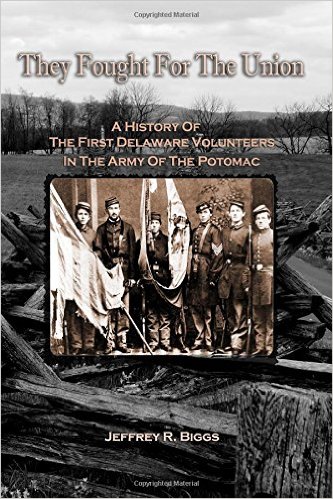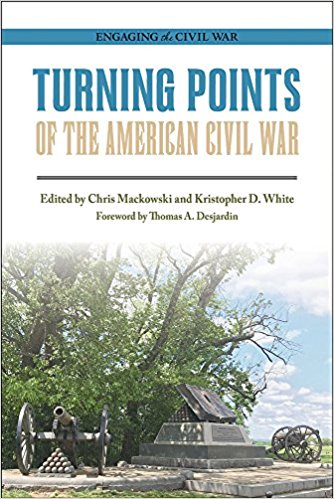They Fought For the Union: A History of the First Delaware Volunteers in the Army of the Potomac by Jeffrey R. Biggs. Belli Civilis Press, 2016. Paper, ISBN: 978-0986361517. $19.99.
 In 1884, Captain William Penn Seville laid the groundwork for this study of a hearty Delaware regiment that fought in Union blue during the Civil War. Seville, as former adjutant, published a hastily assembled history of the First Delaware Regiment at the behest of his comrades-in-arms. In 2016, Jeffrey R. Biggs, a native Delawarean, edited and reissued Seville’s compilations, supplemented with additional content.
In 1884, Captain William Penn Seville laid the groundwork for this study of a hearty Delaware regiment that fought in Union blue during the Civil War. Seville, as former adjutant, published a hastily assembled history of the First Delaware Regiment at the behest of his comrades-in-arms. In 2016, Jeffrey R. Biggs, a native Delawarean, edited and reissued Seville’s compilations, supplemented with additional content.
Perceiving the need for a more comprehensive rendering of the First Delaware’s service, Biggs set about documenting its deeds from recruitment in 1861 until muster out in 1865. It appears that no stone was left unturned in the author’s quest to portray the individual and collective performance of the men of this regiment. He acknowledges a desire to put himself in their shoes, “if only I had lived one hundred and fifty years earlier.”
Following the introductory chapters of They Fought for the Union, which describe the First Delaware’s service guarding and patrolling various installations, the author expands on the regiment’s performance in engagements with the enemy, beginning with the Battle of Antietam and continuing through Appomattox. Throughout this period, the regiment was frequently in the forefront of the action and suffered extensive casualties.
A case in point is the struggle at Antietam Creek near Sharpsburg, Maryland, on September 17, 1862, which cost the 650-man Delaware regiment 286 casualties—or some 44% losses. Biggs states that, “the majority were sustained during the first five minutes.” Exemplifying this carnage, only two of the 10-man color guard escaped being killed or wounded. Despite danger pervading the battlefield, 2nd Lieutenant Charles B. Tanner made a dash under fire and rescued the regimental flag that had fallen near enemy lines. This selfless act earned for him the Medal of Honor.
A few months later at Fredericksburg, the 299 First Delaware troops available to shoulder a rifle or wield a sword were again at the forefront of an ill-advised assault. Casualties numbered 22 killed, 74 wounded, and 9 missing—a loss rate of 30%.
The unit’s heroics continued at Chancellorsville in May 1863, although its losses were not nearly as heavy. The reinforced regiment of 449 men lost 58 killed, wounded or missing. Yet at Gettysburg two months later, it only mustered 232 men, of which 77 or 33% were among the staggering number of Union casualties.
Three Delaware soldiers earned the Medal of Honor for bravery at Gettysburg. In particular, Captain James Parke Postles’ citation read: “Voluntarily delivered an order in the face of heavy fire of the enemy.” Pvt. John B. Maberry and Pvt. Bernard McCarren earned recognition for capturing enemy flags.
Biggs continues his narrative through Ulysses S. Grant’s Overland Campaign in May-June 1864 and the siege of Richmond and Petersburg. He weaves the First Delaware’s story into the fabric of the war in the east in general. Along the way, he assesses the performance of Union commanders, including Generals George B. McClellan, Ambrose E. Burnside, Joseph Hooker, George G. Meade, and Grant.
Although the regiment’s three-year term of enlistment expired in 1864, many members chose to continue serving with the redesignated First Delaware Veteran Volunteers. Some of these brave souls were determined to see the war through to its end, while the offer of a reenlistment bonus (coupled with a 30-day furlough) enticed others.
Combat under the unit’s original flag resulted in 8 officers killed and 21 wounded; 69 enlisted men died and 415 were wounded. All in all, the unit suffered 513 casualties. This was sobering validation that the First Delaware ranked among the most engaged regiments during the Civil War. As the author relates in an epilogue, the men took gratification from this record in later years.
In 1884, the regiment’s survivors officially turned over their flags to the Historical Society of Delaware. In recent years, more than a century later, the Society restored and displayed them to the public with honor and considerable fanfare.
Biggs’ study includes maps, index, bibliography, and extensive notes. It is self-published, and an editor might have usefully trimmed the book—more than 450 pages—in some places. However, the author’s in-depth research and descriptive narrative mitigate these limitations.
In sum, They Fought for the Union is recommended for those who prize comprehensive regimental histories, particularly one featuring a unit from Delaware.
Thomas J. Ryan is the author of the award-winning Spies, Scouts, and Secrets in the Gettysburg Campaign and Essays on Delaware during the Civil War. His weekly column, “Civil War Profiles,” appears in the Coastal Point newspaper in Ocean View, DE.
